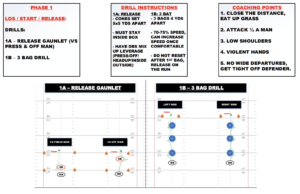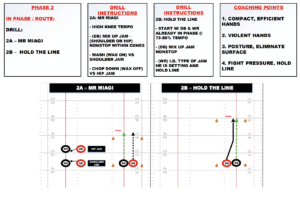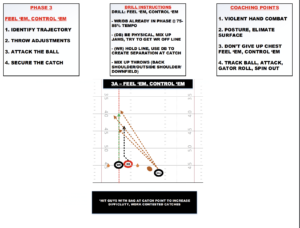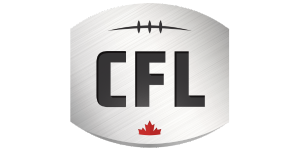
Winning Vertically at the WR Position
August 22, 2023
In my experience, both, playing and coaching the wide receiver position I have come to believe that it can be broken into 3 phases. It is crucial to understand aspects of each phase in order to maximize reps in the vertical pass game.
PHASE 1: RELEASE/START/LOS
As cliché as it may sound, it ALL starts at the line of scrimmage. I am a firm believer that the way we start anything in life is usually indicative of the end result. There is no difference in playing the WR position. The start should always be utilized in setting the wide receiver up to be successful in the end.
(Examples: Stance/Start, Release, Alignment)
PHASE 2: ROUTE/IN PHASE
This phase, in my opinion, is the most neglected of the three. Individual periods during practice are typically used to work on Phase 1 (stance/start, releases) and/or Phase 3 (top of the route, the catch). In my opinion, understanding and mastering Phase 2 is what can get players to become “complete wide receivers” and can accelerate them from good to ELITE.
(Stems, Posture, Pad Level, Eyes, Holding Line, Hand Combat)
PHASE 3: CATCH POINT/FINISH
The finish requires the most focus because it is arguably the most important aspect of the wide receiver position. Guys who are elite in this phase are typically difference-makers regardless of what level they’re playing at. It is the exclamation on the work you’ve done previously. A good route cant be followed with a drop and a reception doesn’t discount a bad route. It must all be put together.
(Top of Route, Catch Point, YAC)
PHASE 1 – KEYS TO WINNING VERTICALLY
Rule #1 is that you MUST win at the line of scrimmage. It goes without saying that in order to consistently win vertically at the wide receiver position one must have a plan and tools that will allow him to win at the line of scrimmage. Most may assume I am referring to beating press man, which is a component we will touch on, however, there are also some things versus an off-corner that a wide receiver can do to win vertically. I could go on for hours about technique at the wide receiver position which all would be applicable, however below are a few phrases and buzz words that I think are vital in knowing how to win vertically:
VS PRESS TECHNIQUE
- Close the Distance
Before working any release, the wide receiver must eat up the grass between he and the DB (press or off coverage).
Working a release with too much grass between you and the DB will not be effective because it leaves the defender
too much room to react and recover after we make our move.
- Attack ½ a Man
Wide receivers facing press man should go into each rep with a point guard’s mentality. When facing press man, you
never want to work down the center of a DB or at his “midline”. We should aim to work on one-half of the DB.
Attacking half a man does a couple of things: First, it gives you a real read on the DB. As a wide receiver if I attack
half a man and the defender does not cover that side up, I will then abort my release and get on my route because
you’re equipped to win on the route with an inside or an outside release. I always tell my guys that the objective is
not to finish your release, but to get on your route as fast as possible. Secondly, working an edge of the defender
helps set up a more efficient “stack” once the wide receiver has made a decision to get vertical on his route.
- Threaten the DB’s Leverage
There are many different ways to threaten the DB. I typically teach about 5 releases and encourage my players to
only master two. However, the objective at the LOS is to get the defender to open his hips, stop his feet, or get him
to change his body position. I refer to this as “getting him off his grass.”
- Get vertical, No Wide Departures
After you’ve gotten the DB to get off his grass, it is now time to get on your route tree. As a WR you always want to
get tight off the defender and never avoid contact. Granted, there will be times when a DB may just open the
gate and a wide receiver gets a clean release, but the majority of times wide receivers try to avoid contact and turn this
scenario into a foot race by running a hump to separate and attempt to stack DBs. This usually ends in the wide
receiver being squeezed to the sideline or the defender working at an angle that allows him to regain ideal leverage.
No wide departures. It will be tough to win vertically if this is happening consistently. Physicality at the WR position
should always be embraced and it starts with a willingness to do so by the wide receiver initiating it and setting the
tone early.
- Understand Angles/Leverage
When attacking DBs off of the line of scrimmage, understanding angles and leverage can be valuable. The angle in
which you attack an off DB can help keep grass and open windows. It can also set you up at the top of the route
creating leverage and separation. When attacking an off-coverage DB I tell my guys to “attack his midline” in order
to keep a 2-way go. Attacking down the center of an off defender allows me, as the WR, to become just as much of
a threat to break outside of the defender as I am to break inside and it keeps the DB from eliminating routes. An
instance where this would be beneficial is against defenses that like to play off quarters coverage with inside
leverage corners. The elite wide receivers understand how to play the game within a game.
BELOW I HAVE INCLUDED CHARTS THAT SHOW DRILLS TO HELP WIDE RECEIVERS AT ANY LEVEL WORK ON THE
TOOLS DESCRIBED ABOVE.

*ADD A TOP OF ROUTE CUT (DIG, CURL, COMEBACK, ETC)
& CONTESTED CATCH AT THE END OF 3 BAG DRILL TO
CHALLENGE GUYS
PHASE 2 – KEYS TO WINNING VERTICALLY
Body Language
Posture If I could give one piece of advice to developing wide receivers it would be this: Force yourself to make everything look the same in your routes. Every time you come off the ball everything should look the same, regardless of your assignment. This prevents the DB from identifying tendencies & indicators and eliminating routes. Posture can be used to influence a defender just as much as a stick step, rocker, or eyes.
Good posture points:
Flat back/Low shoulders
Eyes Up
Running Arms
Knee Drive (Natural Stride Length)
Stems/Sprays
Using different stems to your advantage can be extremely beneficial in the vertical pass game. It goes back to making everything look the same. This is a form of influence. For example, if a DB gets an inside stem from a wide receiver, he is typically alerting a break of some sort (ie: curl, crush corner, dig). Using that same stem to run a vertical could allow you to catch the DB guessing and result in a big play over the top. Creative elements like this make route running fun for guys at any level. Again, you must play the game within the game.
Stack/Hold the Line
As a wide receiver, after a release, whether off or press coverage you should always work to stack a defender. Stacking the DB could be defined as positioning yourself in a position that puts the defender directly behind you.
Drive to separate – Once you have decided to get vertical or feel like you’re in a position to stack the defender, then it is time “drive and separate” from the DB. I usually use a track & field analogy to help paint a picture for my players. When running the 100-meter dash there is a drive phase at the beginning that allows the sprinter to build speed before he/she begins to open up and stride. The same concept applies in football when a wide receiver is looking to separate downfield. The wide receiver’s eyes and shoulders should be downfield in their drive phase. I like to give my guys a yard mark to drive to before they look up to find the ball. It is hard to get to your top speed while looking back for the ball at the same time because you are in an open-shouldered position. I want my guys to trust the technique and drive first and get their eyes up after. Two things are sure to happen when you drive & separate out of the top of deep routes: 1.) You will increase your chances of turning a normally contested catch into an uncontested catch and 2.) You will rarely be overthrown by your quarterback.
Hand combat – When looking to when vertically WRs must have an active “off arm”. Many coaches refer to this as fighting pressure with pressure. It is simply an analogy that emphasizes the use of violent hands when holding your line vs a defender in phase. DBs are coached to “squeeze” you to the sideline once you release. Hand combat is a counter used to allow WRs to either A.) win over the top and stack the defender or B.) If we don’t win over the top, hold the line and save enough grass to allow the quarterback to make a throw the WR can adjust to and stay in bounds. Whether you win the stack or not we have answers and tools to help us win down the field vertically down field.
BELOW I HAVE INCLUDED CHARTS THAT SHOW DRILLS TO HELP WIDE RECEIVERS AT ANY LEVEL WORK ON THE
TOOLS DESCRIBED ABOVE.

ADD A CONTESTED CATCH AT THE END OF THESE DRILLS
ONCE GUYS ARE COMFORTABLE WITH COACHING POINTS
PHASE 3 KEYS TO WINNING VERTICALLY
Body Position
This skill set can be an enormous asset if you have a guy who has mastered it. Obviously, it would be ideal for the wide receiver to stack and run by the defender every snap. However, majority of the time vertical reps don’t play out that clean. Not to mention, there is generally a smaller percentage of completions because of the length of the throw. So what is my answer as a wide receiver when I don’t win the stack? Body Position. Body position is all about putting your body in position and feeling the defender then adjusting to the throw. It goes back to being tight to the defender and feeling him. “If you can feel the defender, you can control him.” As mentioned previously in regards to hand combat, using your off arm to win vertically is a MUST. When a basketball player is driving to the rim and has a defender draped over him, he must use his off arm to help shield the defender and finish at the rim. Similarly, a wide receiver must also use his off arm to create space to finish plays vertically. You should use your off shoulder to feel the defender at all times, and never give up your chest. Not exposing your chest to the DB will give you a higher % chance to make a play on the ball. Feeling the DB
allows you to dictate your adjustment to whatever type of ball is thrown:
-If the ball is thrown over WRs outside shoulder, WR is tight to DB and uses off arm to post up and nudge DB
inside and finish with late hands to secure the catch.
-If the ball is thrown back shoulder, WR is tight to DB and will use off arm to swipe the defender by and attack the
ball in flight to finish
-If the ball is thrown with air downfield, WR will use off arm to club DBs hands and slingshot himself forward, run
underneath the ball to finish the catch.
– If the ball is thrown short, WR is tight to DB and will play the ball through DBs path. This will result in a catch or,
at worst, pass interference because the WRs body positioning forces DB to run through WR during that particular
scenario.
Attack Ball
This is a point that I believe is more of a habitual mentality than a skillset. I truly believe that it can be taught and trained in a way that allows it to come naturally. In any situation, WRs must always attack the ball at the catch point. In jump ball situations the manner in which you attack the ball will give you a higher % chance to finish the play. WRs who look to attack the ball by jumping towards or meeting the ball in flight give themselves a far better chance than those jumping and fading away from the ball. You have to play the percentage game sometimes in jump ball situations. If you have a player who has a knack for it, you are at an extreme advantage as an offense.
“Gator Roll”/Spin Out/Finish
In a jump ball situation, once the WR has gone up and attacked the ball with both hands, as he secures the catch he should violently spin away and box out the defender to help himself secure the catch, similar to a “gator roll”. Positioning himself between the defender and the ball allows the WR to secure the catch and prevents the defender from punching the ball out late.
BELOW I HAVE INCLUDED CHARTS THAT SHOW DRILLS TO HELP WIDE RECEIVERS AT ANY LEVEL WORK ON THE
TOOLS DESCRIBED ABOVE.

*HIT GUYS WITH BAG AT CATCH POINT TO INCREASE
DIFFICULTY, WORK CONTESTED CATCHES
For more information about the AFCA, visit www.AFCA.com. For more interesting articles, check out The Insider and subscribe to our weekly email.
If you are interested in more in-depth articles and videos, please become an AFCA member. You can find out more information about membership and specific member benefits on the AFCA Membership Overview page. If you are ready to join, please fill out the AFCA Membership Application.
« « Previous PostNext Post » »
In my experience, both, playing and coaching the wide receiver position I have come to believe that it can be broken into 3 phases. It is crucial to understand aspects of each phase in order to maximize reps in the vertical pass game.
PHASE 1: RELEASE/START/LOS
As cliché as it may sound, it ALL starts at the line of scrimmage. I am a firm believer that the way we start anything in life is usually indicative of the end result. There is no difference in playing the WR position. The start should always be utilized in setting the wide receiver up to be successful in the end.
(Examples: Stance/Start, Release, Alignment)
PHASE 2: ROUTE/IN PHASE
This phase, in my opinion, is the most neglected of the three. Individual periods during practice are typically used to work on Phase 1 (stance/start, releases) and/or Phase 3 (top of the route, the catch). In my opinion, understanding and mastering Phase 2 is what can get players to become “complete wide receivers” and can accelerate them from good to ELITE.
(Stems, Posture, Pad Level, Eyes, Holding Line, Hand Combat)
PHASE 3: CATCH POINT/FINISH
The finish requires the most focus because it is arguably the most important aspect of the wide receiver position. Guys who are elite in this phase are typically difference-makers regardless of what level they’re playing at. It is the exclamation on the work you’ve done previously. A good route cant be followed with a drop and a reception doesn’t discount a bad route. It must all be put together.
(Top of Route, Catch Point, YAC)
PHASE 1 – KEYS TO WINNING VERTICALLY
Rule #1 is that you MUST win at the line of scrimmage. It goes without saying that in order to consistently win vertically at the wide receiver position one must have a plan and tools that will allow him to win at the line of scrimmage. Most may assume I am referring to beating press man, which is a component we will touch on, however, there are also some things versus an off-corner that a wide receiver can do to win vertically. I could go on for hours about technique at the wide receiver position which all would be applicable, however below are a few phrases and buzz words that I think are vital in knowing how to win vertically:
VS PRESS TECHNIQUE
- Close the Distance
Before working any release, the wide receiver must eat up the grass between he and the DB (press or off coverage).
Working a release with too much grass between you and the DB will not be effective because it leaves the defender
too much room to react and recover after we make our move. - Attack ½ a Man
Wide receivers facing press man should go into each rep with a point guard’s mentality. When facing press man, you
never want to work down the center of a DB or at his “midline”. We should aim to work on one-half of the DB.
Attacking half a man does a couple of things: First, it gives you a real read on the DB. As a wide receiver if I attack
half a man and the defender does not cover that side up, I will then abort my release and get on my route because
you’re equipped to win on the route with an inside or an outside release. I always tell my guys that the objective is
not to finish your release, but to get on your route as fast as possible. Secondly, working an edge of the defender
helps set up a more efficient “stack” once the wide receiver has made a decision to get vertical on his route. - Threaten the DB’s Leverage
There are many different ways to threaten the DB. I typically teach about 5 releases and encourage my players to
only master two. However, the objective at the LOS is to get the defender to open his hips, stop his feet, or get him
to change his body position. I refer to this as “getting him off his grass.” - Get vertical, No Wide Departures
After you’ve gotten the DB to get off his grass, it is now time to get on your route tree. As a WR you always want to
get tight off the defender and never avoid contact. Granted, there will be times when a DB may just open the
gate and a wide receiver gets a clean release, but the majority of times wide receivers try to avoid contact and turn this
scenario into a foot race by running a hump to separate and attempt to stack DBs. This usually ends in the wide
receiver being squeezed to the sideline or the defender working at an angle that allows him to regain ideal leverage.
No wide departures. It will be tough to win vertically if this is happening consistently. Physicality at the WR position
should always be embraced and it starts with a willingness to do so by the wide receiver initiating it and setting the
tone early. - Understand Angles/Leverage
When attacking DBs off of the line of scrimmage, understanding angles and leverage can be valuable. The angle in
which you attack an off DB can help keep grass and open windows. It can also set you up at the top of the route
creating leverage and separation. When attacking an off-coverage DB I tell my guys to “attack his midline” in order
to keep a 2-way go. Attacking down the center of an off defender allows me, as the WR, to become just as much of
a threat to break outside of the defender as I am to break inside and it keeps the DB from eliminating routes. An
instance where this would be beneficial is against defenses that like to play off quarters coverage with inside
leverage corners. The elite wide receivers understand how to play the game within a game.
BELOW I HAVE INCLUDED CHARTS THAT SHOW DRILLS TO HELP WIDE RECEIVERS AT ANY LEVEL WORK ON THE
TOOLS DESCRIBED ABOVE.

*ADD A TOP OF ROUTE CUT (DIG, CURL, COMEBACK, ETC)
& CONTESTED CATCH AT THE END OF 3 BAG DRILL TO
CHALLENGE GUYS
PHASE 2 – KEYS TO WINNING VERTICALLY
Body Language
Posture If I could give one piece of advice to developing wide receivers it would be this: Force yourself to make everything look the same in your routes. Every time you come off the ball everything should look the same, regardless of your assignment. This prevents the DB from identifying tendencies & indicators and eliminating routes. Posture can be used to influence a defender just as much as a stick step, rocker, or eyes.
Good posture points:
Flat back/Low shoulders
Eyes Up
Running Arms
Knee Drive (Natural Stride Length)
Stems/Sprays
Using different stems to your advantage can be extremely beneficial in the vertical pass game. It goes back to making everything look the same. This is a form of influence. For example, if a DB gets an inside stem from a wide receiver, he is typically alerting a break of some sort (ie: curl, crush corner, dig). Using that same stem to run a vertical could allow you to catch the DB guessing and result in a big play over the top. Creative elements like this make route running fun for guys at any level. Again, you must play the game within the game.
Stack/Hold the Line
As a wide receiver, after a release, whether off or press coverage you should always work to stack a defender. Stacking the DB could be defined as positioning yourself in a position that puts the defender directly behind you.
Drive to separate – Once you have decided to get vertical or feel like you’re in a position to stack the defender, then it is time “drive and separate” from the DB. I usually use a track & field analogy to help paint a picture for my players. When running the 100-meter dash there is a drive phase at the beginning that allows the sprinter to build speed before he/she begins to open up and stride. The same concept applies in football when a wide receiver is looking to separate downfield. The wide receiver’s eyes and shoulders should be downfield in their drive phase. I like to give my guys a yard mark to drive to before they look up to find the ball. It is hard to get to your top speed while looking back for the ball at the same time because you are in an open-shouldered position. I want my guys to trust the technique and drive first and get their eyes up after. Two things are sure to happen when you drive & separate out of the top of deep routes: 1.) You will increase your chances of turning a normally contested catch into an uncontested catch and 2.) You will rarely be overthrown by your quarterback.
Hand combat – When looking to when vertically WRs must have an active “off arm”. Many coaches refer to this as fighting pressure with pressure. It is simply an analogy that emphasizes the use of violent hands when holding your line vs a defender in phase. DBs are coached to “squeeze” you to the sideline once you release. Hand combat is a counter used to allow WRs to either A.) win over the top and stack the defender or B.) If we don’t win over the top, hold the line and save enough grass to allow the quarterback to make a throw the WR can adjust to and stay in bounds. Whether you win the stack or not we have answers and tools to help us win down the field vertically down field.
BELOW I HAVE INCLUDED CHARTS THAT SHOW DRILLS TO HELP WIDE RECEIVERS AT ANY LEVEL WORK ON THE
TOOLS DESCRIBED ABOVE.

ADD A CONTESTED CATCH AT THE END OF THESE DRILLS
ONCE GUYS ARE COMFORTABLE WITH COACHING POINTS
PHASE 3 KEYS TO WINNING VERTICALLY
Body Position
This skill set can be an enormous asset if you have a guy who has mastered it. Obviously, it would be ideal for the wide receiver to stack and run by the defender every snap. However, majority of the time vertical reps don’t play out that clean. Not to mention, there is generally a smaller percentage of completions because of the length of the throw. So what is my answer as a wide receiver when I don’t win the stack? Body Position. Body position is all about putting your body in position and feeling the defender then adjusting to the throw. It goes back to being tight to the defender and feeling him. “If you can feel the defender, you can control him.” As mentioned previously in regards to hand combat, using your off arm to win vertically is a MUST. When a basketball player is driving to the rim and has a defender draped over him, he must use his off arm to help shield the defender and finish at the rim. Similarly, a wide receiver must also use his off arm to create space to finish plays vertically. You should use your off shoulder to feel the defender at all times, and never give up your chest. Not exposing your chest to the DB will give you a higher % chance to make a play on the ball. Feeling the DB
allows you to dictate your adjustment to whatever type of ball is thrown:
-If the ball is thrown over WRs outside shoulder, WR is tight to DB and uses off arm to post up and nudge DB
inside and finish with late hands to secure the catch.
-If the ball is thrown back shoulder, WR is tight to DB and will use off arm to swipe the defender by and attack the
ball in flight to finish
-If the ball is thrown with air downfield, WR will use off arm to club DBs hands and slingshot himself forward, run
underneath the ball to finish the catch.
– If the ball is thrown short, WR is tight to DB and will play the ball through DBs path. This will result in a catch or,
at worst, pass interference because the WRs body positioning forces DB to run through WR during that particular
scenario.
Attack Ball
This is a point that I believe is more of a habitual mentality than a skillset. I truly believe that it can be taught and trained in a way that allows it to come naturally. In any situation, WRs must always attack the ball at the catch point. In jump ball situations the manner in which you attack the ball will give you a higher % chance to finish the play. WRs who look to attack the ball by jumping towards or meeting the ball in flight give themselves a far better chance than those jumping and fading away from the ball. You have to play the percentage game sometimes in jump ball situations. If you have a player who has a knack for it, you are at an extreme advantage as an offense.
“Gator Roll”/Spin Out/Finish
In a jump ball situation, once the WR has gone up and attacked the ball with both hands, as he secures the catch he should violently spin away and box out the defender to help himself secure the catch, similar to a “gator roll”. Positioning himself between the defender and the ball allows the WR to secure the catch and prevents the defender from punching the ball out late.
BELOW I HAVE INCLUDED CHARTS THAT SHOW DRILLS TO HELP WIDE RECEIVERS AT ANY LEVEL WORK ON THE
TOOLS DESCRIBED ABOVE.

*HIT GUYS WITH BAG AT CATCH POINT TO INCREASE
DIFFICULTY, WORK CONTESTED CATCHES
For more information about the AFCA, visit www.AFCA.com. For more interesting articles, check out The Insider and subscribe to our weekly email.
If you are interested in more in-depth articles and videos, please become an AFCA member. You can find out more information about membership and specific member benefits on the AFCA Membership Overview page. If you are ready to join, please fill out the AFCA Membership Application.

















